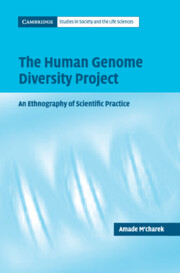Book contents
- Frontmatter
- Contents
- Preface
- 1 Introduction
- 2 Technologies of population: making differences and similarities between Turkish and Dutch males
- 3 Ten chimpanzees in a laboratory: how a human genetic marker may become a good genetic marker for typing chimpanzees
- 4 Naturalization of a reference sequence: Anderson or the mitochondrial Eve of modern genetics
- 5 The traffic in males and other stories on the enactment of the sexes in studies of genetic lineage
- 6 Technologies of similarities and differences, or how to do politics with DNA
- Glossary
- References
- Index
6 - Technologies of similarities and differences, or how to do politics with DNA
Published online by Cambridge University Press: 06 July 2010
- Frontmatter
- Contents
- Preface
- 1 Introduction
- 2 Technologies of population: making differences and similarities between Turkish and Dutch males
- 3 Ten chimpanzees in a laboratory: how a human genetic marker may become a good genetic marker for typing chimpanzees
- 4 Naturalization of a reference sequence: Anderson or the mitochondrial Eve of modern genetics
- 5 The traffic in males and other stories on the enactment of the sexes in studies of genetic lineage
- 6 Technologies of similarities and differences, or how to do politics with DNA
- Glossary
- References
- Index
Summary
This book has dealt with the socio-materiality of genetic diversity in the era of the Diversity Project. It started off by asking what population is, did the same for technology, then went on to consider the autonomous nature of technology and finally that of DNA. Four cases and a few more practices have been examined. The localities investigated were laboratories. Both scientists and DNA were deliberately kept out of focus. Many other aspects were placed center stage. Technologies, individuals, populations, lineage, gifts, races, sexes and blood – among others things – have been central in the previous chapters. They were made part and parcel of the laboratories studied. The analyses examined the heterogeneity of technologies and practices and how these affect the object of geneticists' research. Now it is time to make some links that go beyond each individual case and to narrate stories that reach beyond the Diversity Project. I would like to tell three stories, each aimed at embedding the results of my research in other academic fields: science and technology studies (STS), population genetics as related to the Diversity Project, and gender and anti-racist studies. After each story, I will make a number of points.
I will conclude this chapter by some notes on method.
Naturalization: tracing the politics of nature and technology
Story 1: talking back to STS
This book is a study of laboratories. Such studies are not new in STS. Laboratory studies have been part of the scene ever since the late 1970s.
- Type
- Chapter
- Information
- The Human Genome Diversity ProjectAn Ethnography of Scientific Practice, pp. 148 - 185Publisher: Cambridge University PressPrint publication year: 2005



